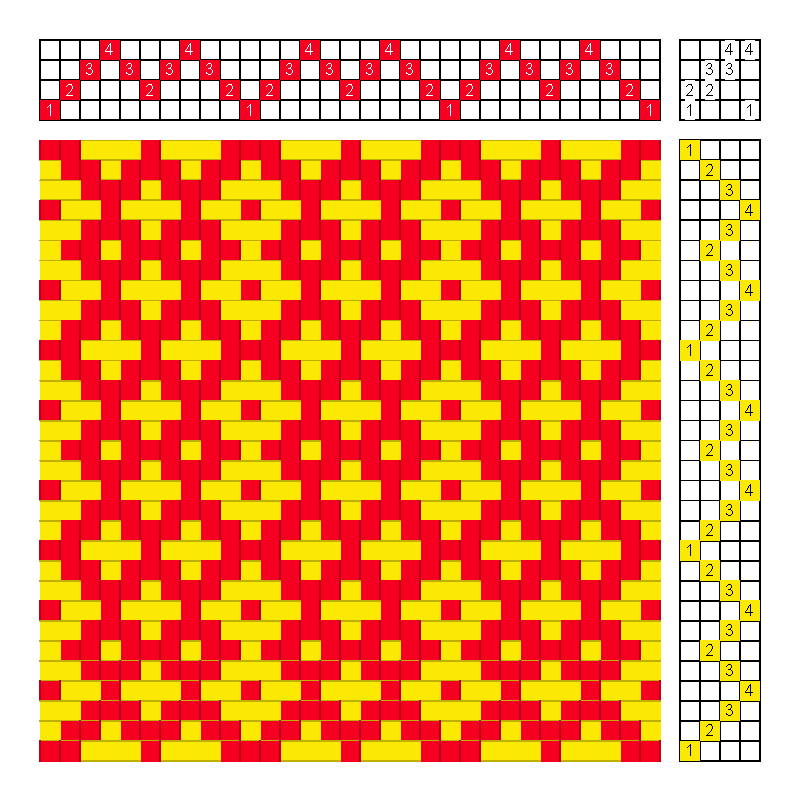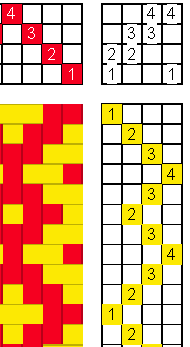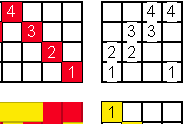Scale and Float length
Marcy Petrini
3/14/2016
Two weeks ago we talked about the threading that appears below in the drawdown. Three repeats are shown, each repeat is 10-thread long. We talked about scale: if the sett is 10 ends per inch, the repeat will be 1” wide (10 thread repeat divided by 10 ends per inch = 1”).
Related to scale is the length of the float: the larger the pattern, the longer the floats, for any given pattern. We know this, of course, but, like scale, we may forget to consider it. The treadling is needed to assess float length, since the floats are formed in the weaving. We need to think about warp and weft floats.

The drawdown of this twill is shown as tromp as writ. To determine float length in inches (and fractions thereof) first we need to determine thread float length. Drawdown software may provide such analysis, but really, it is rather easy to figure out.
The drawdown shows clearly the horizontal red lines that represent the warp and the vertical yellow lines that represent the weft. Let’s first look at the warp ends. Each red square is a single warp float. Follow the analysis by looking at this section of the drawdown:

The first warp thread is on shaft 1.Only single red squares appear, thus, floats are only one-warp long.
The warp end on shaft 2 has the following floats, starting from the top of the drawdown: 2, 1, 3. Only one repeat of the treadling is needed for analysis, but the joint between the first and second repeat is important; it is, in fact, here that the 3-thread float occurs.
For shaft 3 we have: 2, 3, 2 thread floats.
For shaft 4: 3, 3 thread floats.
Thus, for the warp, the maximum warp length float is over 3 threads.
Next, we analyze weft floats, the yellow horizontal lines; each yellow square is a single weft float. Again, follow the analysis by looking at this particular section of the drawdown:

For the first shot (1 & 2), the weft float length is 3 threads; for shaft 2 only single thread floats. On shaft 3: 2, 1, 3; on shaft 4: 2, 3, 2
Thus, the maximum weft length float is also over 3 threads.
This process sounds laborious, but it doesn’t have to be; make the drawdown high contrast in color and the longest length and width of the colors will become more obvious; focusing on the longest red lines, we easily see that there are no warp floats longer than 3; similarly, looking at the longest yellow lines shows that there are no weft floats longer than 3 threads.
We do have to remember, however, that longer floats may be occurring underneath the cloth. Any time that we have two or more warp ends next to each other, as it occurs in the first shot shown below, there is an equivalent float underneath the cloth, in this example, a two-thread yellow weft float.

If you have trouble visualizing what floats lurk underneath the cloth, do a drawdown exchanging shaft movement: if the original drawdown was for a rising shed loom (as in the case here), repeat it for a sinking shed loom and vice versa. Below is the sinking shed drawdown, the underneath of the fabric; note, at the first shot, the two-thread yellow weft float that we just talked about.

There are no floats longer than 3 threads for either the warp or the weft.
Once we have determine the float length in threads, we can convert it to inches, using the sett for the weft floats and the beat (picks per inch) for the warp floats.
For example, using the sett of 10 ends to the inch we mentioned above, where the pattern will be 1” wide, the weft float over 3 warp threads will be about ⅓”; whether this is acceptable or not depends on the final use of the fabric. At a sett of 20 epi, the pattern is less visible at ½” wide, but the floats are minimal at 0.15”.
We can do the same approximation for the warp floats based on the beat, which may or may not be the same as the sett.
With a little planning, we can get the pattern in the size we want with acceptable floats.
Please email comments and questions to This email address is being protected from spambots. You need JavaScript enabled to view it..